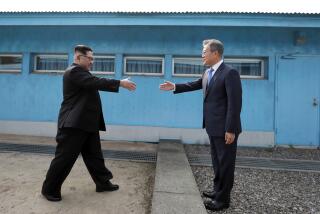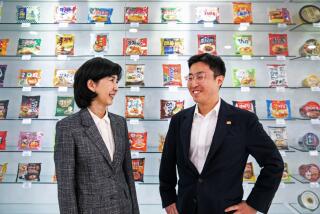PACIFIC RIM TRADE : Asia : How Two Giants Emerged From War’s Rubble and Grew : Japan and South Korea took similar paths to economic renewal. But Seoul still has war on its mind.
- Share via
SEOUL — In 1987, South Korea’s government trade organization issued a paper that tried to quell increasing fears that the nation’s fast-growing economy was becoming another trade headache for the United States and others. The title: “Korea Is Not Another Japan.”
Ever since this East Asian tiger roared forward with spectacular economic growth built on the rubble of war, comparisons with Japan have, for better or worse, been inevitable.
Most of the scrutiny has been motivated by efforts to learn the secret of the “economic miracle” enjoyed by both nations. On the surface, the similarities are striking: Both nations built their war-shattered economies largely on exports, close cooperation between government and business and Confucian ethics of education, strong family ties and hard work.
But as both nations amassed burgeoning trade surpluses, U.S. business leaders and politicians began seeing a darker side to the miracle as well. The “export or die” mentality, critics said, led both nations to dump products abroad to win market share while protecting their home turfs with all sorts of trade barriers.
In fact, a look at the economic strategies of both nations shows differences as well as similarities in their paths to becoming postwar trade giants.
Still, South Korean officials say Japan served as their biggest role model in pushing what was largely an agrarian economy into today’s world-class producer of ships, semiconductors and automobiles.
“We just followed the Japanese model instinctively,” recalled Kyong Shik Kang, economics minister under former presidents Park Chung Hee and Chun Doo Hwan. “They are our nearest neighbors, and we frequently visited Japan.”
Sometimes, Kyong said, Korean officials followed Japan a bit too blindly. Even after the oil shock in the early 1970s, South Korea continued to try to build up its chemical industry, though the highly inflated oil prices made it unprofitable to do so.
*
“People thought, ‘Japan built up its petrochemical industry, and since we are at a similar stage we have to do it.’ It was a foolish mistake,” he said.
For both nations, the start was similar. Both South Korea and Japan face the same geographical fate: They are located in areas lacking oil, mineral riches and other natural resources crucial for industrialization. Both nations, exhausted by war, also faced shortages of hard currency.
As a result, both nations chose a similar basic strategy to build up national wealth: Export products abroad, earn foreign currency and use that to buy the resources needed to further develop industries.
“In the beginning, we didn’t have much foreign exchange, so we couldn’t aggressively import or open our markets,” said Nam Sam Woo, a senior fellow at the Korea Development Institute. “All we could do was push hard with exports and, with those proceeds, import a lot of raw materials and machinery needed for domestic production. Given the resources at the time, it was the right choice.”
Both nations also took similar paths in choosing products to export. Initially, top exports were silk, fish products, textiles and other primary commodities. As industrialization proceeded, however, manufactured goods emerged as the dominant export. In 1962, for instance, primary commodities made up 73% of South Korea’s total exports, but that figure dropped to 10% by 1974 and 5% by 1987, according to government statistics.
Capitalizing on their relatively low labor costs, both nations began moving into light industry, such as clothing, plywood and footwear. And, in both cases, discriminatory wage policies toward women helped keep labor costs low. In 1980, for instance, the gender wage gap was larger in South Korea--women earned 44.5% of men’s pay--than in any other country providing data to the International Labor Organization; the dubious distinction fell to Japan in some years, such as 1984.
As average wages increased, however, planners had to scramble to develop products with ever higher value. That meant shifting to products requiring more capital and technology, such as computers, semiconductors and the like.
*
In both cases, government officials played strong roles in planning and controlling the growth. The South Korean government, for instance, used tax breaks, regulations and its control over credit allocation and exchange rates to push Korean business to develop specific industries, expand production and increase export capacity.
Both countries also relied on what Harvard Prof. Tu Wei-ming calls “new Confucian ethics” to support the industrialization drive. According to Tu and others, such ethics place an emphasis on education, government leadership, consensus and a strong work ethic. But unlike traditional Confucianism, which disdained merchants as money-grubbers and placed them on the bottom of the social ladder below scholars, farmers and artisans, the “new” ethics glorified business activities and the entrepreneurial spirit.
The result in both countries, analysts say, was a pool of highly educated and well-trained workers who viewed their firms as a family bound by mutual obligations and loyalty.
But the two nations also differed in their approaches. One major distinction was that Japan largely financed its growth with its own pool of savings, while South Korea depended heavily on foreign borrowing.
Japan also developed a fairly good balance between large conglomerates and small and medium-sized enterprises, while South Korea’s development was spurred almost exclusively by the large business groupings, the conglomerates known as chaebol , said KDI’s Nam.
While the chaebols ‘ large scale has enabled South Korea to undertake such massive enterprises as shipbuilding and overseas construction, it has also led to a greater concentration of industry than in Japan. That, in turn, has led to some economic inefficiency-- chaebols are never permitted to go bankrupt--as well as mounting social protests.
Analysts say another major difference was the role that military concerns played in shaping the economy. Japan renounced war and downgraded its military to defensive forces after its World War II defeat, and for most of its high-growth period it spent less than 1% of its gross national product on defense.
South Korea, however, lives under the shadow of heavily armed North Korea and spends 5% or more of its gross national product on defense. Military concerns have also shaped the direction of industrial development. After President Richard Nixon withdrew one-third of U.S. forces in South Korea and President Jimmy Carter proposed removing them entirely in the 1970s, a nervous South Korea began building up defense-related industries, such as shipbuilding, said Kyong, the former economics minister.
*
All of these policies and conditions have brought relative prosperity to South Koreans, who now have an average per capita income of $7,000, compared to less than $100 in 1969.
But the “export or die” mentality that boosted South Korea and Japan into today’s trading giants may be a policy whose time has past. As the world moves toward an open trading system in the post-Cold War era, the formula of exporting abroad while protecting one’s home market is not likely to be tolerated.
That reality is all too painful in South Korea, where President Kim Young Sam battles to open his nation’s markets in the new order of global liberalization even as he faces the old order of Stalinist North Korea.
“Now we face many difficulties,” Kyong said. “We should become cosmopolitan and adjust to the post-Cold War world. But on the Korean Peninsula, the Cold War continues.”
More to Read
Sign up for Essential California
The most important California stories and recommendations in your inbox every morning.
You may occasionally receive promotional content from the Los Angeles Times.










